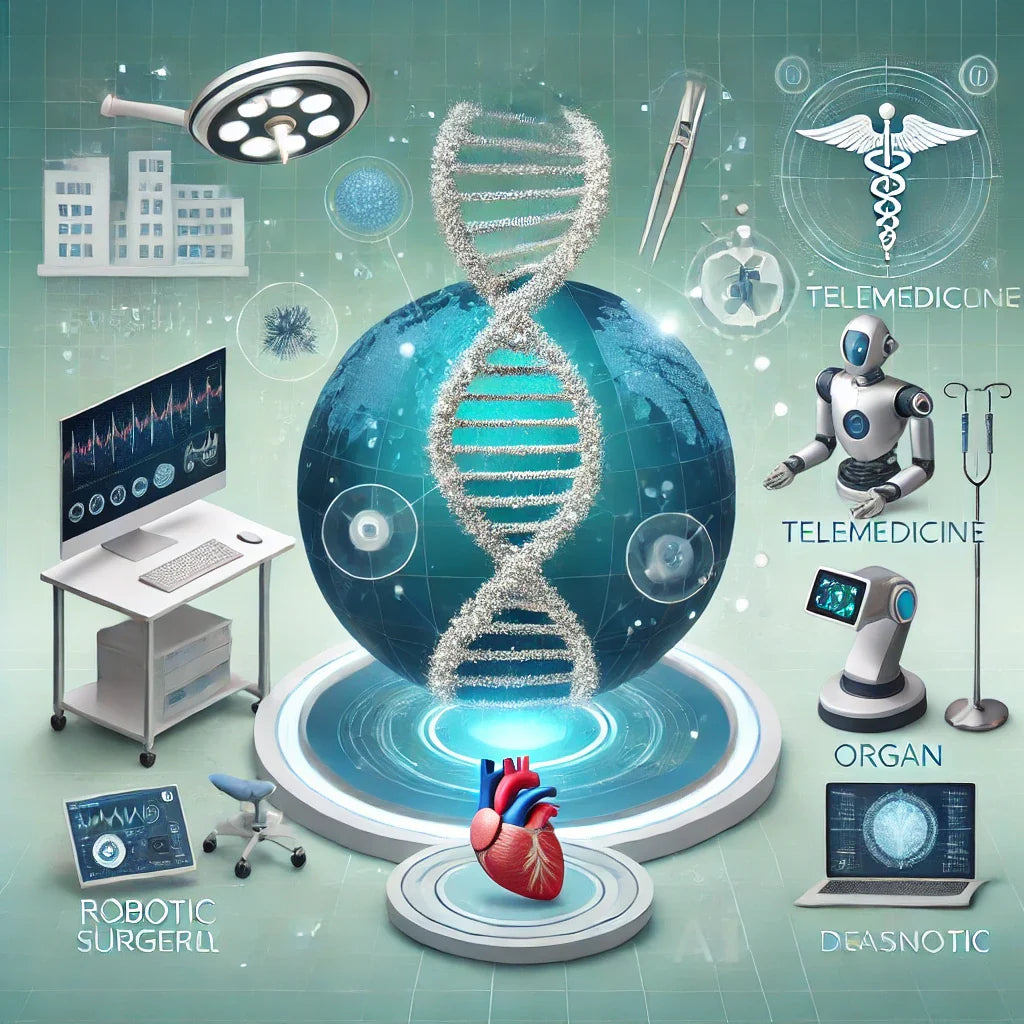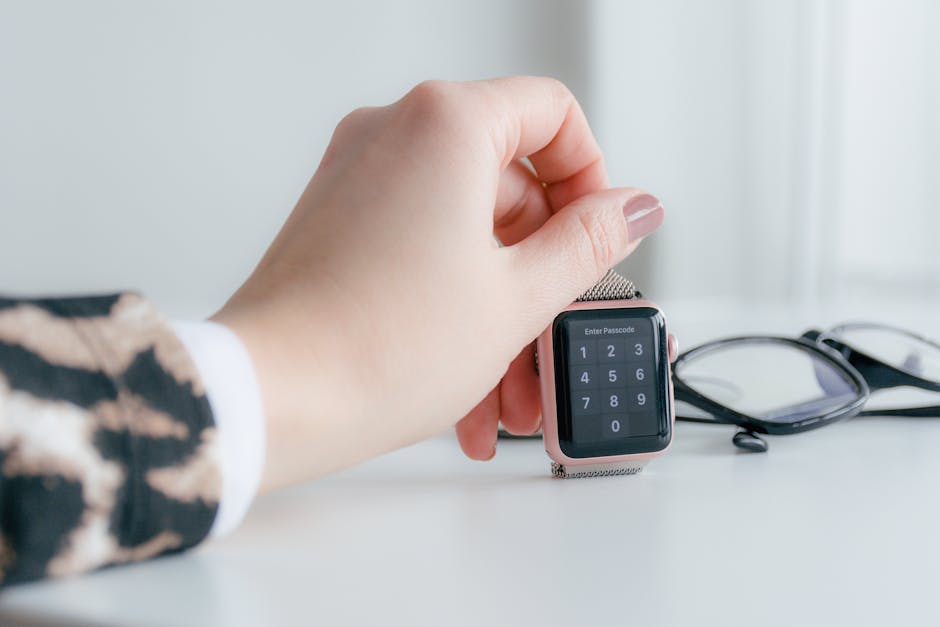
5 Innovations Revolutionizing Global Healthcare
|
|
Time to read 10 min
|
|
Time to read 10 min
Health tech innovations are changing the way healthcare is delivered, making it more efficient and effective:
In today's world, health tech innovations bring great promise. They are driving down costs, improving patient outcomes, and making high-quality healthcare more accessible. According to Deloitte, the IoMT will be worth $158.1 billion by 2022, demonstrating its increasing impact. These technologies bring vital patient data straight to healthcare providers, enhancing overall care and response times.
I'm Robert Resz, a biohacker and digital storytelling expert. I bring a creative approach to health tech, aiming to make innovations accessible and beneficial for everyone.
Smartwatch EKGs are wearable devices that provide crucial cardiovascular insights. They represent a significant leap in early detection and advanced health monitoring.
Apple's EKG app for Apple Watches is a great example. It's physician-approved and designed to detect irregular heart rates. This is especially important for people with atrial fibrillation (AFib), a condition affecting over 2.5 million Americans annually. Early detection can be life-saving.

Wearable EKGs send alerts when they detect abnormal heart rhythms. This data can be shared with doctors instantly. Solutions like RapidSOS enable immediate data transfer to healthcare providers, with user permission. This quick action can make a huge difference in emergencies.
Beyond EKGs, smartwatches are packed with other health-monitoring features. They track heart rate, physical activity, and even blood oxygen levels. For example, some smartwatches use Photoplethysmography (PPG) to measure blood volume changes. This tech provides a comprehensive view of your health, helping with accurate diagnoses.
Consider a scenario where a person feels dizzy one afternoon. Their smartwatch detects an irregular heartbeat and sends an alert. They go to the hospital immediately, where doctors confirm they are having a heart attack. The quick detection and response can save lives.
Smartwatch EKGs are more than just gadgets; they are powerful tools in modern healthcare. They offer continuous monitoring, early warning systems, and valuable data for healthcare providers.
Next, we'll explore the exciting world of Smart Pills and how they revolutionize internal health monitoring.
Smart pills are cutting-edge biometric scanners that you can swallow. They perform a variety of medical functions internally, providing doctors with unprecedented insights into your health.
Unlike traditional methods, smart pills can scan and image your internal organs from the inside. They can measure body temperature, pH levels, and detect signs of ulcers or tumors along the gastrointestinal tract. This makes them a less invasive and more cost-effective option compared to other diagnostic tools.
Smart pills aren't just for monitoring; they can also deliver drugs. These nonpermanent sensors pass through your system once their job is done. They can release medication in specific areas of your body, ensuring that treatment is targeted and effective. This precision reduces side effects and increases the chances of successful treatment.
Imagine a patient with a chronic gastrointestinal condition. Traditional methods might require invasive procedures to monitor and treat the issue. A smart pill can be swallowed, provide detailed internal images, and deliver medication directly to the affected area. This not only improves the patient's comfort but also improves the effectiveness of the treatment.

As technology advances, we can expect even more capabilities, such as real-time data transmission to doctors and more sophisticated drug delivery systems.
Smart pills represent a significant leap in innovative health solutions. They offer a non-invasive, efficient, and precise way to monitor and treat various medical conditions, revolutionizing the way we approach internal health.
Next, we'll dig into Remote Medical Consults and Monitoring and how telemedicine is changing healthcare.
Telemedicine has emerged as a game-changer in healthcare, especially during the COVID-19 pandemic. It allows doctors to diagnose and treat patients remotely, ensuring that even those in rural or underserved areas have access to medical care.
With platforms like Zoom, Skype, and EasyMeet, doctors can now conduct virtual health consultations. This means that patients can receive medical advice without leaving their homes. For example, a patient in a remote village can consult with a specialist in a major city, saving time and travel costs.
Remote diagnosis isn't just about video calls. IoMT sensors (Internet of Medical Things) play a crucial role. These sensors can monitor a patient’s vitals like heart rate, blood pressure, and glucose levels in real-time. The data is then transmitted to healthcare providers, allowing for accurate and timely diagnosis.
In emergencies, remote medical conferencing can be a lifesaver. Imagine a situation where a rural clinic faces a critical case but lacks the expertise. A remote consultation with a specialist can help rapidly diagnose and triage the patient, ensuring they receive the right treatment promptly.
IoMT sensors also enable continuous monitoring of patients with chronic conditions. For instance, a patient with a heart condition can wear a smart EKG device. If an abnormal rhythm is detected, the device can automatically alert both the patient and their doctor, enabling quick intervention.

Consider the case of a patient with diabetes. Traditional monitoring methods might require frequent clinic visits. With IoMT sensors, the patient’s glucose levels can be tracked continuously. The data is sent to their doctor, who can adjust treatment plans in real-time. This not only improves the patient's quality of life but also reduces healthcare costs.
Telemedicine and remote monitoring are revolutionizing healthcare by making it more accessible, efficient, and responsive. As technology continues to advance, we can expect even more innovative solutions to emerge, further changing the landscape of global healthcare.
Next, we'll explore how Wearable Biometric Sensors are enhancing health monitoring and fitness tracking.
Wearable biometric sensors are changing the way we monitor our health and fitness. These devices, embedded in everyday items like smart clothing and accessories, provide real-time insights into our physical well-being.
Imagine your shirt tracking your heart rate or your socks monitoring your steps. Smart clothing integrates sensors into fabrics, making health tracking seamless. These garments can measure everything from heart rate to muscle activity, providing valuable data for fitness enthusiasts and patients alike.
RFID chips (Radio-Frequency Identification) in wearables offer another layer of functionality. These tiny chips can store and transmit data about your health metrics. For instance, they can be used in hospitals to track patient vitals and ensure timely medication administration.
One of the most common features in wearables is heart rate monitoring. Devices like smartwatches continuously track your heart rate, alerting you to any irregularities. This is crucial for early detection of conditions like atrial fibrillation, potentially saving lives.
Wearables also help users set and achieve fitness goals. By tracking metrics like steps taken, calories burned, and distance covered, these devices motivate users to stay active. Apps connected to these wearables often provide personalized workout plans and progress reports.
Monitoring sleep patterns is another significant benefit. Smartwatches and fitness bands can track your sleep stages, helping you understand the quality of your rest. This data can be used to make lifestyle changes that improve sleep, which is essential for overall health.
Consider a person training for a marathon. With wearable biometric sensors, they can monitor their heart rate, track their running distance, and even analyze their sleep patterns to ensure they are well-rested. This comprehensive data helps them optimize their training and improve performance.
Wearable biometric sensors are revolutionizing health monitoring by making it more integrated, personalized, and accessible. As technology advances, these devices will become even more sophisticated, offering deeper insights into our health and fitness.
Next, we'll dig into how AI and Deep Learning for Diagnosis are changing medical data analysis and diagnostic accuracy.
Artificial intelligence (AI) and deep learning are revolutionizing healthcare by enhancing diagnostic accuracy and efficiency. These technologies analyze vast amounts of medical data to provide advanced diagnostic tools, aiding doctors in making informed decisions.
AI systems can process and analyze complex medical data much faster than humans. For example, advanced AI platforms can review and store vast amounts of medical information, from journals to case studies, exponentially faster than any human. This helps healthcare providers make more accurate diagnoses and treatment plans.
Deep learning algorithms, a subset of AI, are particularly powerful. They use neural networks to learn from massive datasets. These algorithms can detect patterns and anomalies in medical data, offering insights that were previously unattainable.
AI's ability to analyze medical data is changing diagnostics. A high proportion of mammograms yield false results, leading to unnecessary biopsies. AI can review mammograms 30 times faster with 99% accuracy, significantly reducing these false positives. This not only saves time but also reduces patient stress and healthcare costs.
AI-powered diagnostic tools are becoming more sophisticated. For example, AI models can predict the 3D structures of proteins, which is crucial for drug discovery and understanding diseases at a molecular level. Similarly, AI can forecast the binding affinity between drugs and their targets, aiding in more effective drug development.
Consider the case of cancer diagnosis. AI can process whole slide images (WSI) of tissue samples using computer vision and convolutional neural networks. This technology highlights areas of interest where potential cancer cells may be located, reducing the time required for diagnosis. This approach supports healthcare professionals, allowing them to focus on critical areas and make quicker, more accurate decisions.
AI is also making strides in mental health diagnostics. For instance, AI models can analyze human speech to detect early signs of dementia. These models distinguish between the speech patterns of healthy individuals and those exhibiting symptoms of dementia, allowing for early intervention and treatment.
While AI offers numerous benefits, it also presents challenges. The performance of AI models depends on the quality of the training data. Additionally, ethical considerations around data privacy and the need for explainable AI are crucial. Healthcare organizations must ensure robust security measures to protect patient data and maintain trust.
AI and deep learning are changing healthcare by providing powerful tools for diagnosis and treatment. These technologies are not only improving accuracy but also making healthcare more efficient and personalized.
Next, we'll explore how Frequently Asked Questions about Health Tech Innovations can help you stay informed and make better healthcare decisions.
Health tech innovations refer to the use of digital technologies to improve healthcare delivery and patient outcomes. This includes everything from wearable devices like smartwatches and fitness trackers to complex databases that store and analyze medical data. The goal is to make healthcare more efficient, cost-effective, and accessible.
For instance, wearable devices like the Apple Watch can monitor your heart rate and even perform an EKG. This helps in early detection of conditions like atrial fibrillation, potentially saving lives. These devices bring critical health information right to your wrist, making it easier to stay on top of your health.
One of the newest technologies in healthcare is artificial intelligence (AI). AI is being used to analyze vast amounts of medical data, making it easier for healthcare providers to diagnose and treat conditions. For example, AI can analyze medical images to detect anomalies much faster and more accurately than humans.
Machine learning is another exciting innovation. It involves training algorithms to learn from data, improving their accuracy over time. This technology is being used in drug findy, predictive analytics, and personalized treatment plans. For example, AlphaFold2 by DeepMind predicts the 3D structure of proteins, which is crucial for developing new drugs.
Technological innovations in healthcare are changing the way we diagnose, treat, and manage diseases. Here are some key innovations:
These innovations are not just improving the healthcare system—they are revolutionizing it. They offer more personalized, efficient, and accurate care, making healthcare better for everyone.
Next, we'll dive into how wearable biometric sensors are reshaping our understanding of health and fitness.
As we wrap up our exploration of health tech innovations, it's clear that the future of healthcare is both exciting and promising. At Rad Creative Wellness, we believe in using these advancements to foster a more patient-driven healthcare experience.
Patient-driven healthcare is all about putting control back into the hands of individuals. With tools like wearable biometric sensors and AI-driven diagnostics, patients can monitor their health in real-time and make informed decisions. This shift not only empowers patients but also helps healthcare providers offer more targeted and effective treatments.
One of the key benefits of these innovations is personalized care. By using high-quality sensor data from wearable devices, healthcare providers can tailor treatments to each individual's unique needs. For example, smartwatches that monitor heart rate and sleep patterns can provide valuable insights that lead to more personalized health plans.
At Rad Creative Wellness, we integrate creativity with scientific wellness practices to offer a holistic approach to health. Our goal is to inspire and empower you to explore new dimensions of wellness that resonate with your unique journey.
For more information on how you can leverage these innovations, check out our biohacking devices collection and start changing your health today.
By embracing these technologies, we can move towards a future where healthcare is more efficient, accessible, and personalized. The innovations we discussed are not just changing the way we approach health—they are revolutionizing it.